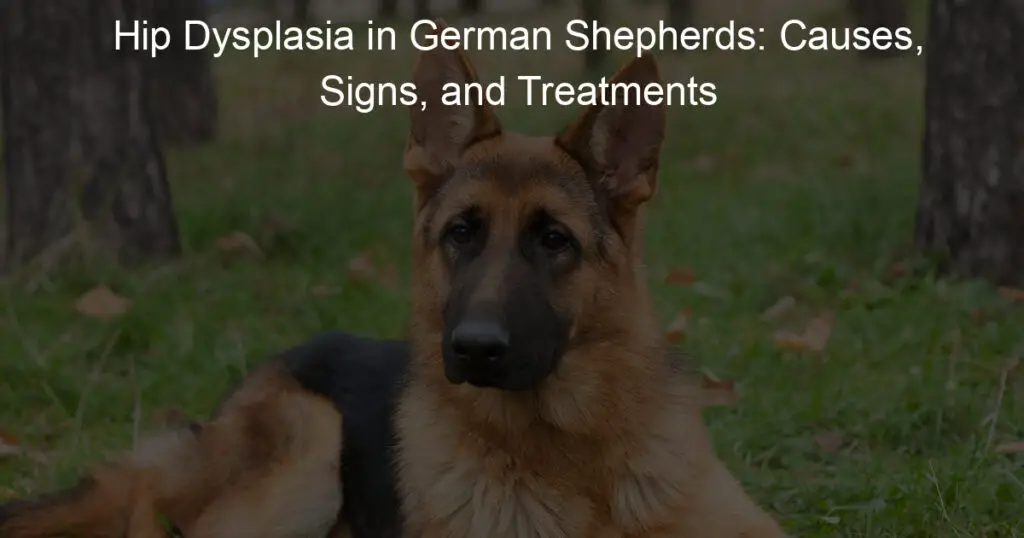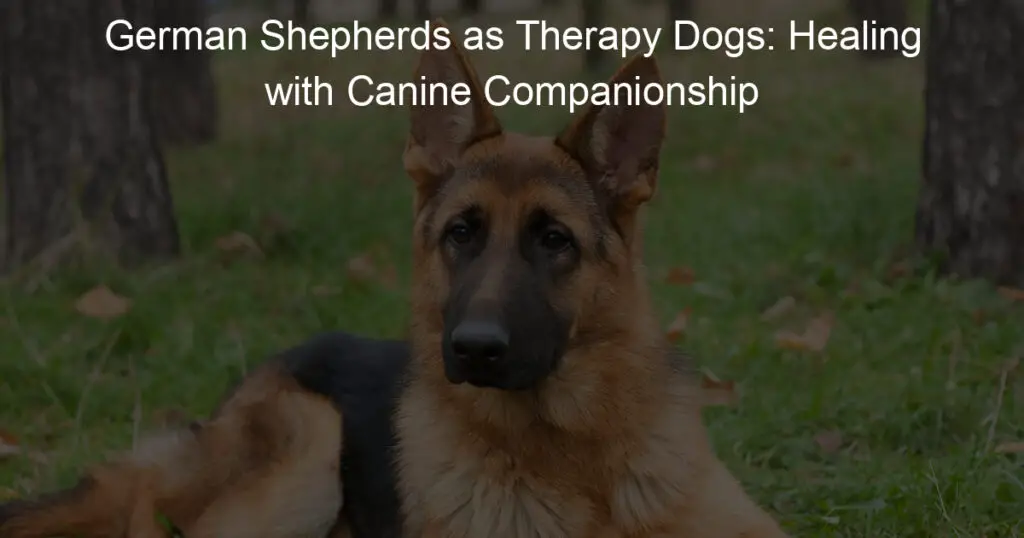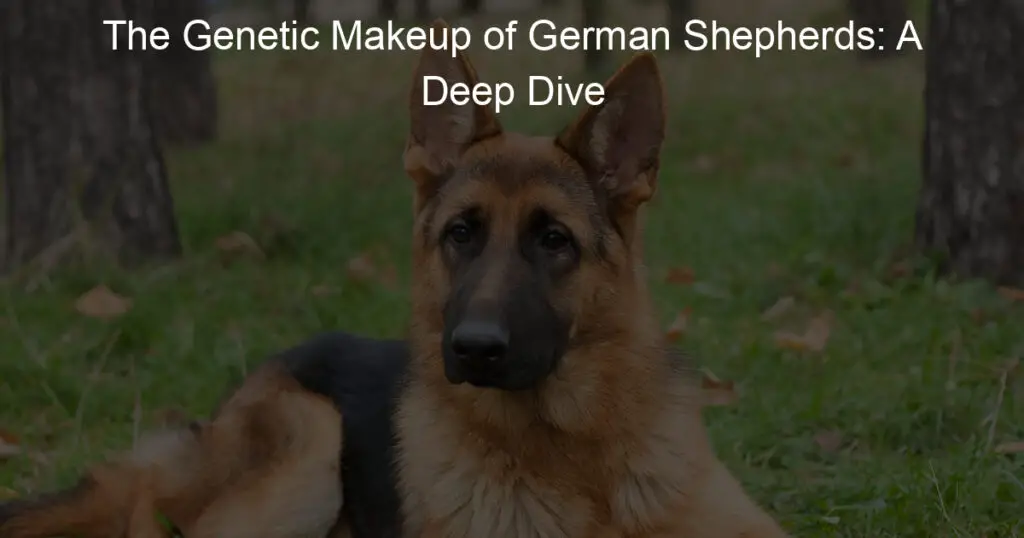This blog post explores the issue of hip dysplasia in German Shepherds, a common and serious health concern among this breed. It delves into the causes, signs, and potential treatments for this condition, providing comprehensive insights for owners and breeders.
Understanding Hip Dysplasia: What is it?
Hip dysplasia is a common orthopedic condition that affects the hip joint in dogs, including German Shepherds. It is characterized by the abnormal development of the hip joint, leading to instability and eventual degeneration. The hip joint consists of a ball and socket, with the ball (femoral head) fitting into the socket (acetabulum). In dogs with hip dysplasia, the ball and socket do not fit together properly, causing friction and wear on the joint surfaces. This can lead to pain, lameness, and difficulty in movement for the affected dog.
Hip dysplasia can vary in severity, ranging from mild to severe. In mild cases, the dog may only experience occasional stiffness or discomfort. However, in severe cases, the condition can significantly impact the dog's quality of life, causing chronic pain and mobility issues. While hip dysplasia is more commonly seen in large and giant breed dogs, it can affect dogs of all sizes.
The exact cause of hip dysplasia is not fully understood, but it is believed to be a combination of genetic and environmental factors. Genetic predisposition plays a significant role, as dogs with parents affected by hip dysplasia are more likely to develop the condition themselves. Environmental factors, such as rapid growth, excessive weight gain, and inappropriate exercise, can also contribute to the development and progression of hip dysplasia.
Why are German Shepherds more prone?
There are several reasons why German Shepherds are more prone to hip dysplasia compared to other breeds.
- 1. Genetics:
German Shepherds have a genetic predisposition to hip dysplasia. The condition is believed to be hereditary, and dogs with a family history of hip dysplasia are more likely to develop the condition themselves. Breeding practices that do not prioritize hip health can contribute to the prevalence of hip dysplasia in German Shepherds. - 2. Rapid Growth:
German Shepherds are known for their rapid growth rate. During the puppy stage, their bones and joints develop quickly, which can increase the risk of hip dysplasia. Fast growth can put additional stress on the hip joint, leading to abnormal development and instability. - 3. Conformation:
The conformation or structure of German Shepherds can also make them more prone to hip dysplasia. Their unique body shape, with a sloping back and angulated hindquarters, puts increased strain on the hip joint. This conformation can result in poor alignment of the hip joint, leading to instability and the development of hip dysplasia over time.
"Genetic Factors: What role do they play?"
Genetic factors play a significant role in the development of hip dysplasia in German Shepherds. This condition is considered to be polygenic, meaning that it is influenced by multiple genes. While specific genes responsible for hip dysplasia have not been identified, it is believed that a combination of genes related to joint structure, cartilage development, and collagen formation contribute to the development of this condition.
German Shepherds with a family history of hip dysplasia are more likely to pass on the condition to their offspring. Responsible breeders strive to reduce the prevalence of hip dysplasia by selectively breeding dogs with good hip scores and no history of hip problems. Genetic screening and hip evaluations are commonly performed to identify dogs with a lower risk of passing on hip dysplasia.
In addition to familial genetic factors, new mutations can also arise in German Shepherds that may increase the risk of hip dysplasia. These spontaneous genetic changes can occur during the development of the embryo or throughout the dog's life. Although these mutations may not be as common as familial genetic factors, they can still contribute to the development of hip dysplasia in certain individuals.
Environmental Factors: Are they contributors?
Yes, environmental factors can contribute to the development and progression of hip dysplasia in German Shepherds. While genetics play a significant role, the environment in which a dog grows and develops can influence the severity of the condition.
First, diet and nutrition are crucial factors to consider. Proper nutrition during the early growth stages is essential for the development of healthy bones and joints. Imbalances in diet, such as excessive or inadequate nutrient intake, can negatively impact skeletal development and increase the risk of hip dysplasia. It is important to provide a balanced and appropriate diet for German Shepherds, especially during their rapid growth phase.
Secondly, overexertion and excessive exercise can also contribute to the development of hip dysplasia. High-impact activities, such as jumping or running on hard surfaces, can put excessive stress on the hip joints, leading to wear and tear. It is important to provide controlled exercise and avoid activities that may strain the joints, particularly during the early growth stages when the joints are still developing.
Thirdly, maintaining a healthy weight is crucial for managing hip dysplasia. Excess weight places additional strain on the joints, increasing the likelihood of joint problems and exacerbating existing hip dysplasia. It is important to monitor the weight of German Shepherds and provide a balanced diet and regular exercise to help them maintain a healthy body condition.
Recognizing the Signs: How can you tell?
Hip dysplasia can cause a range of symptoms in German Shepherds, and being able to recognize these signs is crucial for early detection and intervention. One common sign is difficulty in rising or getting up from a lying position. You may notice your German Shepherd struggling or showing discomfort when trying to stand up, especially after periods of rest. Additionally, you may observe a decreased range of motion in the hind limbs, making it difficult for your dog to fully extend or flex their hips. Lameness or limping, particularly in the hind legs, can also be indicative of hip dysplasia. Pay attention to any changes in your dog's gait or a noticeable favoring of one leg over the other. Another sign to look out for is a bunny hop-like movement when your German Shepherd walks or runs. This occurs when both hind legs move together in a hopping motion, rather than moving independently. It's important to note that some dogs may show signs of pain or discomfort when their hips are manipulated or touched. They may exhibit sensitivity or exhibit signs of aggression when pressure is applied to the hip area. If you notice any of these signs, it is recommended to consult with a veterinarian for a thorough examination and diagnosis. Early identification of hip dysplasia can significantly improve the chances of effective management and treatment. By being aware of these signs and seeking veterinary care, you can ensure the well-being and quality of life for your German Shepherd.
"When should you consult a Veterinarian?"
It is crucial to consult a veterinarian if you suspect your German Shepherd may be suffering from hip dysplasia. While some dogs may show obvious signs of discomfort, others may be more subtle in their symptoms. If you notice any changes in your dog's mobility or behavior, it is best to seek professional advice. As a responsible dog owner, you should consult a veterinarian if you observe any of the previously mentioned signs, such as difficulty rising, decreased range of motion, lameness, or a bunny hop-like gait. Additionally, if your German Shepherd shows signs of pain or sensitivity when their hips are touched or manipulated, it is important to have them evaluated by a professional. Early detection and intervention can make a significant difference in managing hip dysplasia and preventing further deterioration of the joints. A veterinarian will be able to conduct a thorough physical examination and may recommend further diagnostic tests, such as X-rays, to confirm the presence and severity of hip dysplasia. They will also be able to provide you with appropriate treatment options based on your dog's specific condition. Remember, only a veterinarian can make an accurate diagnosis and develop a tailored treatment plan for your German Shepherd. Delaying or avoiding veterinary consultation can lead to worsening symptoms and a decreased quality of life for your beloved pet. So, if you have any concerns or suspicions about your German Shepherd's hip health, it's best to consult with a veterinarian as soon as possible. They are the experts who can guide you in providing the best care for your furry friend.
Diagnostic Tests for Hip Dysplasia
To determine if your German Shepherd has hip dysplasia, there are several diagnostic tests available. One commonly used method is a physical examination by a veterinarian, where they will assess your dog's range of motion, joint stability, and any signs of pain or discomfort. This initial examination can provide valuable insights into the presence of hip dysplasia. However, to obtain a definitive diagnosis, more advanced imaging techniques are often necessary. One such test is an X-ray, which allows for a detailed evaluation of the hip joint structure. X-rays can reveal abnormalities such as joint laxity, uneven development of the femoral head and acetabulum, and the presence of osteoarthritis. Another diagnostic tool that may be used is a hip evaluation using the Orthopedic Foundation for Animals (OFA) scoring system. This system grades the severity of hip dysplasia based on X-ray findings, providing a standardized assessment. Additionally, veterinarians may recommend a computed tomography (CT) scan or magnetic resonance imaging (MRI) for a more detailed view of the hip joint. These imaging techniques can help in assessing the degree of joint laxity, the condition of the surrounding soft tissues, and the presence of any secondary complications. In some cases, a veterinarian may suggest a joint fluid analysis to rule out other possible causes of joint inflammation and pain. It is important to note that these diagnostic tests may require sedation or anesthesia, as they often involve positioning the dog in specific ways to obtain accurate images. The results of these tests will help your veterinarian determine the severity of the hip dysplasia and develop an appropriate treatment plan tailored to your dog's specific needs. By accurately diagnosing hip dysplasia, you can take the necessary steps to manage the condition and improve your German Shepherd's quality of life.
Exploring Treatment Options: What can you do?
When it comes to treating hip dysplasia in German Shepherds, there are several options available that can help alleviate pain, improve mobility, and enhance your dog's overall quality of life. Here are three common treatment approaches:
- 1. Conservative Management:
In mild cases of hip dysplasia, conservative management may be recommended. This approach focuses on non-surgical methods and includes measures such as weight management, controlled exercise, and physical therapy. Maintaining a healthy weight is crucial, as excess weight can put additional stress on the hips. Regular, low-impact exercise, such as swimming or walking on soft surfaces, can help strengthen the muscles around the hip joint. Physical therapy techniques like hydrotherapy and therapeutic exercises can also improve joint stability and range of motion. - 2. Medications and Supplements:
To manage pain and inflammation associated with hip dysplasia, your veterinarian may prescribe medications such as non-steroidal anti-inflammatory drugs (NSAIDs) or analgesics. These medications can provide short-term relief, but long-term use should be carefully monitored. Additionally, certain supplements like glucosamine and chondroitin sulfate can support joint health and slow down the progression of degenerative changes in the hip joint. - 3. Surgical Interventions:
In more severe cases or when conservative management does not provide adequate relief, surgical options may be considered. The most common surgical procedure for hip dysplasia is a total hip replacement, where the damaged hip joint is replaced with an artificial one. This procedure can significantly improve mobility and reduce pain. Another surgical option is a femoral head and neck ostectomy (FHO), which involves removing the femoral head and allowing the surrounding muscles to support the joint. This procedure is typically reserved for smaller dogs or those with certain complications that make a total hip replacement less feasible.
Surgical Treatments: Are they necessary?
When it comes to hip dysplasia in German Shepherds, surgical treatments are not always necessary, but they can be highly beneficial in certain cases. The decision to pursue surgery typically depends on the severity of the hip dysplasia and the impact it has on the dog's quality of life.
In cases where conservative management and medication do not provide sufficient relief, surgery may be recommended. Surgical interventions are particularly beneficial for younger dogs with severe hip dysplasia, as they can help restore normal joint function and prevent further degeneration.
Total hip replacement (THR) is one surgical option that can provide excellent outcomes. During THR, the damaged hip joint is replaced with an artificial one, allowing for improved mobility and reduced pain. This procedure is especially effective for dogs with advanced hip dysplasia or those who require long-term pain management.
Another surgical option is the femoral head and neck ostectomy (FHO). This procedure involves removing the femoral head, allowing the surrounding muscles to support the joint. FHO is typically recommended for smaller dogs or cases where a total hip replacement is not feasible.
It's important to note that surgical treatments carry risks and require careful consideration. Recovery from surgery can be lengthy, and there is always the possibility of complications. Additionally, surgical treatments can be costly, so financial considerations should also be taken into account.
Ultimately, the decision to pursue surgery should be made in consultation with a veterinarian who can thoroughly evaluate your German Shepherd's condition and provide guidance based on their expertise. They will consider factors such as the dog's age, overall health, and lifestyle to determine if surgery is the best course of action.
"How can Physiotherapy help?"
Physiotherapy can play a crucial role in managing hip dysplasia in German Shepherds. It focuses on improving joint mobility, strengthening muscles, reducing pain, and enhancing overall physical function.
Physiotherapy techniques, such as therapeutic exercises, stretching, and massage, can help alleviate muscle imbalances and improve range of motion in the affected hip joint.
Additionally, physiotherapists can create personalized treatment plans that target specific areas of weakness or discomfort. These plans may include exercises to strengthen the core and hindquarters, as well as hydrotherapy sessions for low-impact conditioning.
Physiotherapy can also help manage pain through modalities like cold laser therapy or ultrasound. These non-invasive techniques promote tissue healing, reduce inflammation, and provide pain relief.
Regular physiotherapy sessions can significantly improve your German Shepherd's mobility, allowing them to lead a more comfortable and active life. It's important to note that physiotherapy should be performed by a qualified professional with experience in canine rehabilitation.
They will assess your dog's condition, develop a tailored treatment plan, and guide you on how to perform exercises or techniques at home. Consistency and commitment are key to achieving positive results with physiotherapy.
While physiotherapy can be highly beneficial, it is not a standalone treatment for hip dysplasia. It is often used in combination with other interventions, such as medication or surgery, to provide comprehensive care.
By incorporating physiotherapy into the management of hip dysplasia, you can support your German Shepherd's physical well-being and enhance their overall quality of life.
Role of Diet and Supplements in Managing Hip Dysplasia
Proper nutrition and targeted supplements can play a significant role in managing hip dysplasia in German Shepherds. By providing the right nutrients and supplements, you can support joint health, reduce inflammation, and improve overall mobility.
- 1. Balanced Diet:
A balanced diet is essential for dogs with hip dysplasia. It should consist of high-quality protein sources, such as lean meats, to support muscle development and maintenance. Omega-3 fatty acids, found in fish oils or flaxseed, are known for their anti-inflammatory properties and can help reduce joint inflammation. Additionally, a diet rich in antioxidants, vitamins, and minerals can support the body's natural healing processes. - 2. Joint Supplements:
There are various supplements available that specifically target joint health in dogs. Glucosamine and chondroitin sulfate are commonly used to promote the production of healthy joint cartilage and reduce the progression of hip dysplasia. These supplements can be found in the form of chews, tablets, or powders. Other beneficial supplements may include MSM (Methylsulfonylmethane) and hyaluronic acid, which help lubricate the joints and improve flexibility. - 3. Weight Management:
Maintaining a healthy weight is crucial for dogs with hip dysplasia. Extra weight puts additional stress on the joints, exacerbating the condition. A balanced diet and portion control can help prevent weight gain and reduce strain on the hips. Consult your veterinarian to determine the appropriate caloric intake for your German Shepherd based on their age, activity level, and overall health.
"Can lifestyle modifications make a difference?"
Absolutely! Lifestyle modifications can make a significant difference in managing hip dysplasia in German Shepherds. By making a few adjustments to your dog's daily routine and environment, you can help minimize pain, discomfort, and the progression of the condition.
- 1. Exercise:
Regular exercise is crucial for maintaining muscle strength and joint mobility. However, it is important to strike a balance. High-impact activities such as jumping or intense running can put excessive strain on the hips. Instead, focus on low-impact exercises like swimming or controlled walks to keep your German Shepherd active without causing further damage. Consult with your veterinarian or a professional dog trainer to develop a suitable exercise plan for your dog's specific needs. - 2. Environmental Modifications:
Creating a safe and supportive environment is key. Providing soft bedding or orthopedic dog beds can help cushion the joints and provide comfort during rest. Ramps or stairs can be used to avoid excessive jumping onto furniture or navigating stairs, reducing stress on the hips. Additionally, avoid slippery surfaces that can lead to slips and falls, as these can cause further injury to the affected joints. - 3. Weight Management:
Maintaining a healthy weight is vital for dogs with hip dysplasia. Excess weight puts additional strain on the joints, exacerbating the condition. By ensuring your German Shepherd maintains a healthy weight through a balanced diet and portion control, you can help reduce stress on the hips and improve overall mobility.
Living with Hip Dysplasia: What does the future hold?
Living with hip dysplasia can be challenging, but with the right management and care, German Shepherds can still lead fulfilling lives. While the condition is not curable, there are various treatments and lifestyle adjustments that can help improve your dog's quality of life. It's essential to remember that every dog is different, and the progression of hip dysplasia can vary. Some German Shepherds may experience minimal symptoms and lead relatively normal lives, while others may require ongoing medical support and assistance.
Regular veterinary check-ups are crucial to monitor the progression of hip dysplasia and adjust treatment plans accordingly. Your veterinarian may recommend periodic X-rays or other diagnostic tests to assess the condition of the hips and evaluate the effectiveness of the chosen treatments. This will help determine if any adjustments need to be made to your dog's management plan.
In severe cases where conservative treatments are no longer effective, surgery may be an option. Surgical procedures such as total hip replacement or femoral head ostectomy can provide relief and significantly improve mobility. However, it's important to note that surgery may not be suitable for all dogs, and the decision should be made in consultation with your veterinarian.
In addition to medical interventions, providing your German Shepherd with a supportive and loving environment is crucial. Offering plenty of mental and physical stimulation, regular exercise within their limitations, and a healthy diet can all contribute to their overall well-being. Emotionally, it's important to provide them with love and attention, as they may experience discomfort or pain.
Common Causes, Signs, and Treatments for Hip Dysplasia in German Shepherds:
| Common Causes | Signs | Diagnosis | Treatments |
|---|---|---|---|
| Genetics, Diet, Overweight, Injury | Lameness, Difficulty Rising, Pain in Hind Legs | X-ray, Physical Exam, Blood Test | Weight Management, Surgery, Supplements |
| Poor Nutrition, Rapid Growth, Lack of Exercise | Limping, Difficulty Climbing Stairs, Difficulty Jumping | Physical Exam, X-ray, Blood Test | Weight Management, Surgery, Joint Supplements |
| Inherited Traits, Environment, Injury | Lameness, Reduced Mobility, Pain in the Hip Joint | X-ray, Physical Exam, Blood Test | Weight Management, Surgery, Medication |
| Genetic Predisposition, Poor Nutrition, Lack of Exercise | Reluctance to Walk, Difficulty Rising, Pain in the Hind Legs | Physical Exam, X-ray, Blood Test | Weight Management, Surgery, Medication |
Hip dysplasia in German Shepherds is a significant health issue, but with early detection and proactive management, affected dogs can lead happy, comfortable lives. By understanding the causes, recognizing the signs, and exploring effective treatments, owners can ensure the best possible care for these loyal and intelligent dogs.















